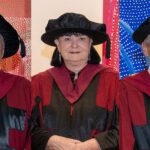Curtin researchers have developed a tiny electrical circuit that may enable an entirely new design of digital devices.
The electrical circuit is made from crystals of copper that are grown and electrically wired at nanoscale and may lead to digital devices that have increasing amounts of computational power packed into a smaller space.
In a paper published today in the leading nanotechnology journal ACS Nano, researchers used a single nanoparticle to create an ensemble of different diodes – a basic electronic component of most modern electronic devices, which functions by directing the flow of electric currents.
Lead researcher PhD candidate Yan Vogel, from Curtin’s School of Molecular and Life Sciences and the Curtin Institute for Functional Molecules and Interfaces, said the research team used a single copper nanoparticle to compress in a single physical entity that would normally require many individual diode elements.
Mr Vogel said the research showed that each nanoparticle had an in-built range of electrical signatures and had led to something akin to ‘one particle, many diodes’, thereby opening up the concept of single-particle circuitry.
Mr Vogel said the breakthrough would enable new concepts and methods in the design of miniaturised circuitry.
“Instead of wiring-up a large number of different sorts of diodes, as is done now, we have shown that the same outcome is obtained by many wires landing accurately over a single physical entity, which in our case is a copper nanocrystal,” Mr Vogel said.
Team leader Dr Simone Ciampi, also from Curtin’s School of Molecular and Life Sciences and the Curtin Institute for Functional Molecules and Interfaces, said the new research followed that published by himself and his Curtin colleague Dr Nadim Darwish in 2017, when they created a diode out of a single-molecule, with a size of approximately 1 nanometer, and would help to continue the downsizing trend of electronic devices.
“Last year, we made a breakthrough in terms of the size of the diode and now we are building on that work by developing more tuneable diodes, which can potentially be used to make more powerful and faster-thinking electronic devices,” Dr Ciampi said.
“Current technology is reaching its limit and molecular or nanoparticle diodes and transistors are the only way that we can continue the improvement of computer performances. We are trying to contribute to the development of the inevitable next generation of electronics.”
This research was co-authored by Dr Darwish and Ms. Jinyang Zhang, also from Curtin’s School of Molecular and Life Sciences and the Curtin Institute for Functional Molecules and Interfaces.
The report, ‘Switching of Current Rectification Ratios within a Single Nanocrystal by Facet-Resolved Electrical Wiring’ can be found online here.



